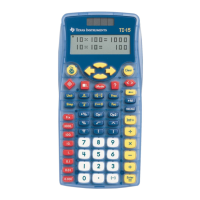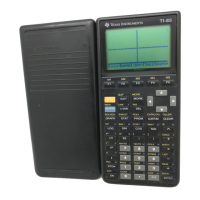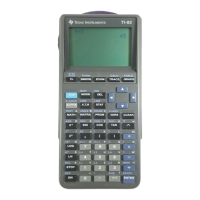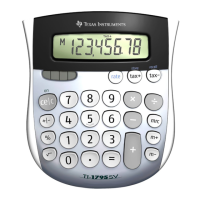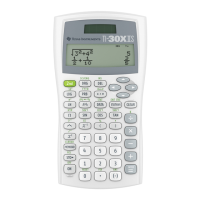Floating-point results are used. See cos() for
calculation details.
LnReg xlist,ylist[,[freqList],[catlLst],[catincList]]
Calculate logarithmic regression and update all
statistics variables. First four arguments must
be variable names or c1-c99. Last argument
need not be a variable name and cannot be
c1-c99. All lists except catincList must have
equal dimension. The regression equation is
y = a + b*ln(x).
Local var1 [,var2, var3, ...]
Declare the arguments as local variables in a
program or function. Local variables exist only
during program or function execution. Local
variables must be used for loop index variables
and for storage in multi-line functions, since
global variables are not allowed in functions.
Lock var1 [,var2, var3, ...]
Lock the argument variables. Locked variables
cannot be changed or deleted unless Unlock() is
used.
log()
(expr), (list)
Return the base-10 logarithm of the argument.
(matrix)
Return the matrix base-10 logarithm of square
diagonalizable matrix. This is not the same as
finding the logarithm of each matrix element.
Floating-point arithmetic is used. Refer to cos()
for calculation details.
Logistic xlist,ylist[,[freqList],[catlLst],[catincList]]
Calculate logistic regression and update all
statistics variables. First four arguments must
be variable names or c1-c99. Last argument
need not be a variable name and cannot be
c1-c99. All lists except catincList must have
equal dimension. The regression equation is
where e is the natural
y =
a
1+b
$
e
c
$
x
+ d
logarithm base.
Loop
Loop : block : EndLoop
Repeatedly execute block until a Goto or Exit
instruction is executed.
LU matrix, lMat, uMat, pMat [,tol]
Calculator the Doolittle LU (lower-upper) matrx
decomposition or real or complex matrix. matrix
must be a matrix name. The results are
lMat = lower triangular matrix
uMat = upper triangular matrix
pMat = permutation matrix
such that lMat * uMat = pMat * matrix
Any matrix element is set to zero if its value is
less than tol and matrix contains no
floating-point or symbolic elements. The default
value for tol is 5E-14 * max(dim(matrix)) *
rowNorm(matrix). Computations are done with
floating-point arithmetic in Approx mode.
mat▶
▶▶
▶list(matrix)
Return a list whose elements are those of
matrix, row by row.
max()
(expr1,expr2), (list1,list2), (matrix1,matrix2)
Return the maximum of the arguments. List and
matrix arguments are compared element by
element.
(list)
Return the maximum element of list.
(matrix)
Return a row vector whose elements are the
maximum elements of the columns of matrix.
mean(list[,freqList])
Return the mean of the elements of list. freqList
indicates the number of occurrences of the
corresponding list element.
(matrix[,freqMatrix])
Return a row vector whose elements are the
means of the matrix columns. freqMatrix
indicates the number of occurrences of the
corresponding matrix element.
median()
(list)
Return the median of the elements of list. All list
elements must simplify to numbers.
(matrix)
Return a row vector whose elements are the
medians of the columns of matrix. All matrix
elements must simplify to numbers.
15 - 12

